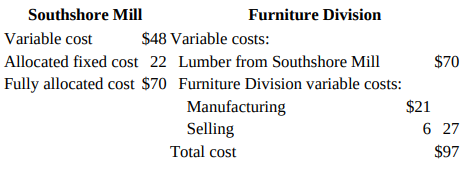The Furniture division of Barrie Woodcraft purchases lumber, which it uses to fabricate tables, chairs, and other
Question:
The Furniture division of Barrie Woodcraft purchases lumber, which it uses to fabricate tables, chairs, and other wood furniture. Most of the lumber is purchased from the Southshore Mill, also a division of Barrie Woodcraft. Both the Furniture division and Southshore Mill are profit centres.
The Furniture division proposes to produce a new Danish-designed chair that will sell for $92. The manager is exploring the possibility of purchasing the required lumber from the Southshore Mill. Production of 800 chairs is planned, using capacity in the Furniture division that is currently idle.
The Furniture division can purchase the lumber from an outside supplier for $72. Barrie Woodcraft has a policy that internal transfers are priced at fully allocated cost.
Assume the following costs for the production of one chair and the lumber required for the chair:

1. Assume that the Southshore Mill has idle capacity and therefore would incur no additional fixed costs to produce the required lumber. Would the Furniture division manager buy the lumber for the chair from the Southshore Mill, given the existing transfer pricing policy? Why or why not? Would the company as a whole benefit if the manager decides to buy from the Southshore Mill? Explain.
2. Assume that there is no idle capacity at the Southshore Mill and the lumber required for one chair can be sold to outside customers for $70. Would the company as a whole benefit if the manager decides to buy? Explain.
Step by Step Answer:

Management Accounting
ISBN: 978-0132570848
6th Canadian edition
Authors: Charles T. Horngren, Gary L. Sundem, William O. Stratton, Phillip Beaulieu





